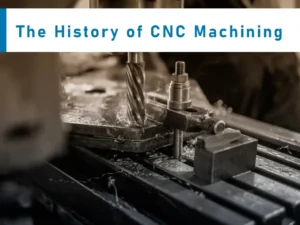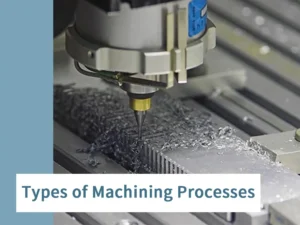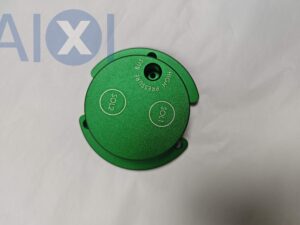In the past few years, part manufacturing technology has been greatly developed to adapt to the changing needs of various production sectors. Machining is one of the main techniques, which is done by removing shavings from raw materials to make high-precision parts. In the past, relatively simple 3-axis machining tools were used to do this, but the use of numerically controlled (CNC) 5-axis machining has now been greatly modernized. But what do these two processing technologies need? What are the main factors that distinguish between three-axis machining and five-axis machining? The answer is in this article.
Milling is an important technology used in CNC precision machining with applications in medical, aerospace, optical and mechanical parts. Milling uses a rotating tool to remove material from the workpiece by feeding the workpiece at an angle relative to the tool axis. The axis of the milling machine determines the type of workpiece and the position that can be done on the workpiece. Here, let’s take a look at the 3-axis, 4-axis and 5-axis machining methods, their differences and which ones to choose for your part.

Traditional three-axis machining
3-axis machining is one of the most widely used techniques for manufacturing machine parts. For decades, it has been known to manufacturers and other participants in the industrial sector as well as in many other fields such as architecture, design and art. Using a conventional machining tool such as a milling machine, this is a relatively simple process that allows material to be machined on three axes (X, Y and Z). The processing tool then continues to remove the shavings in three basic directions corresponding to the plane axis. It is ideal for parts that are not too deep, but this technique is greatly limited when trying to deal with deeper parts with narrow cavities. In this way, the work can become very laborious and produce an imperfect surface effect.
3-axis milling is a development from the practice of rotary boring, which is a milling process on the X and Y axes. In three-axis machining, the workpiece remains stationary while the cutting tool moves along three axes to mill the part. 3-axis machining is still one of the most widely used techniques for manufacturing machine parts and can be used for automatic/interactive operation, milling, drilling and cutting sharp edges. Since the 3-axis machining can only be performed on 3 axes, it is relatively simple, and the material can be removed from the back to the front, from the side to the side and from the top to the bottom.
Although this is the most basic machining process, three-axis machining may be ideal for your machining project, depending on the size of the production run, workpiece requirements, accuracy and finish limits, materials used, and your gripping capabilities.
4-axis milling involves the same process involved in 3-axis machining where a cutting tool is used to remove material from the workpiece to create the desired shape and contour. However, in four-axis machining, milling is performed on an additional shaft. The 4-axis CNC machine runs on the X, Y and Z axes like a 3-axis machine, but it also includes rotation around the X-axis (called the A-axis). This is the 4th axis added during our machining process. In most cases, the workpiece will rotate to allow cutting around the B axis.
Four-axis milling is useful when you need to punch or cut holes in the sides or cylinders of the workpiece. They can provide fast and efficient work based on the computer’s digital input to get accurate results.
With the advent of new demands and the introduction of new computer-aided manufacturing technology (CAM), new processing technologies with 3 + 1 axis, 3 + 2 axis and 5 axes were developed.
Five-axis machining: more advanced technology
As the name suggests, five-axis machining uses a tool that moves in five different directions, corresponding to three linear X, Y, and Z axes, and adds two axes A and B, around which the tool The axes rotate. With this configuration, the part can be accessed from all directions and can be machined from five sides in one operation.
Unlike three-axis machining, this technology is ideal for deeper parts made of hard materials and ensures high precision thanks to the use of shorter machining tools. The machining speed is also faster, while reducing tool vibration.
In addition, although the operation of the three-axis machining is relatively simple, the five-axis machining requires a longer preparation time, but requires less material processing.
Digital control, the advantages of five-axis machining
5-axis machining includes all axes for 4-axis machining and an additional rotary axis. The 5-axis milling machine is the best CNC milling machine available today, creating precise and complex parts for artificial bones, aerospace products, titanium sheets, oil and gas mechanical parts, automotive molds, medical, construction and military products. The fifth axis in the 5-axis milling machine surrounds the B-axis, while the B-axis rotates around the Y-axis in the X-Y-Z plane. This multi-dimensional rotation and tool movement gives the B-axis unmatched precision, finish and speed in the production of workpieces. 5-axis machining produces very complex parts, which is why it is so important in advanced applications such as aerospace applications.
However, five-axis machining has also become more popular as it offers the option of single-step machining (reduced lead-time), better access to part geometry, and improved tool life by tilting the table and Processing efficiency. The ideal cutting position.
Therefore, which type of processing should be selected for the project. It all depends on your unique requirements, budget and schedule. For expert advice, please contact one of our professional precision engineers to find the right match for your needs.
In the past few years, a number of hardware and software have been developed to provide completely computer-based control of processing tools for 5-axis machining. These digital controls make it possible to efficiently process a wide range of materials and surfaces with high precision. This computer aided manufacturing (CAM) also allows the process to be partially or fully automated. In addition to high quality, sophisticated products, this technology has many advantages. Faster processing speeds, higher yields and the ability to manufacture very large parts.
At USIMM, the manufacturing technology we use is perfect for the needs of your different projects. We can use 3-axis or 5-axis machining as needed to ensure truly customized results on a variety of non-metallic materials including plastics, plexiglass, polystyrene, wood, foam, MDF, etc. In addition, through digital cutting, our team also provides comprehensive support for your project, from 3D scanning to turning it into reality.
Why do you want to perform five-axis machining?
Some people mistakenly believe that five-axis technology is only suitable for the most complex parts. Although it does excel in this regard, most applications are only used to machine the five sides of the workpiece in a single setup. For three-axis machining, the job may require two, three or more settings to get all the features of the part. Use the all-in-one approach to eliminate these other settings in addition to the potential errors you make each time you reposition a part. For these reasons, the reason for using a five-axis machine is simple, greatly reducing the overall setup, machine time and fixtures.
Another inherent advantage of five-axis machining is that it can use shorter tools because the tool/tool holder combination can be tilted from surfaces or features on the workpiece that would otherwise create interference. This is especially important in mold and mold processing where shank extension is typically used to reach the deep cavity surface. Shorter tools reduce vibration for larger or faster cuts, better surface finish and longer tool life.
Especially for the shop, five-axis machining can cut complex parts from solid materials, otherwise casting may be required. This allows for short-term machining and prototyping of high-value parts quickly. This is a great opportunity to differentiate stores from low-tech competitors and build more profitable businesses.
Five-axis technology for parts
First, consider your parts. How old are they? How much do they heavier? What level of accuracy do they need?
For example, if the part is small to medium, then with today’s technology, a tiltable benchtop machine would be the best choice. If the part is large and heavy, it may be the only option – a hinge that may be on a gantry machine or a horizontal machining center. With this in mind, you can narrow down your selection and help you compare the features of the various machine models within the required range.
Starting from the 3 + 2 machining center
The easiest and cheapest way to get the five sides of a part is to use a 3 + 2 machine configuration. For small and medium-sized machines, it usually means that the three-axis machining uses a tiltable rotary table to position the part. Of course, this can be done with an auxiliary two-axis table on a standard three-axis machining center. However, machines with integrated tilting tables provide better machining performance and are easier to set up and program.
With the 3 + 2 machining center, the fourth and fifth axes are locked while the part is being machined. Despite this, almost all of the workpiece’s plane can be displayed on the spindle, and surprisingly, complex parts can also be cut efficiently.
In the case of AIXI hardware, the main advantage of the complete five-axis control is that you can now dynamically tilt the tool into the slit, away from the interference area, or keep the tool vector constant while feeding a tilted or free-flowing surface. This is why five-axis machining is so widely used in aerospace components, orthopedics and other parts with bending functions.
For several other parts, the five axes help to use the cutting tool more efficiently. Tilting the tool relative to the surface of the workpiece makes better use of the milling slot, which is usually cut with the side of the tool instead of the end.
In addition, with the three-axis process, the ball end mill has almost no other way to create a contoured surface. To obtain a smooth surface, multiple passes are required and the step size is very small, which can take a lot of machine time and may still require another auxiliary process to smooth the tip. In 5-axis machining, you can even use a flat end mill to create certain contoured surfaces. In what is sometimes referred to as “broach milling”, the tool is tilted into the slit to show the radius of the tool to the surface of the part.
The full five-axis control feature makes it easier to access more features of the part because the tool can be dynamically tilted away from the interference area on the part. Complete five-axis control gives you the opportunity to refine hard-to-reach features such as the corners of grooves or bosses and create a smoother surface during this process. This feature eliminates the need for secondary processing, such as sinker EDM in mold processing.
CNC technology is the base for automation, flexibility and integrated production in the manufacturing industry. It is the core of modern manufacturing technology and an indispensable means to improve the product quality and labor productivity of the manufacturing industry.
The application range of CNC machinery:
1. High-speed, precision CNC lathes, turning centers and multi-axis combined machining machines. Mainly meet the needs of aerospace, aviation, instrumentation, instrumentation, electronic information and bioengineering industries.
2. High-speed, high-precision CNC milling and boring machine and high-speed, high-precision vertical horizontal machining center. It mainly meets the needs of large-scale complex structural brackets, shells, cabinets, light metal materials and precision parts for automobile engine cylinder heads and aerospace, high-tech industries.
3, heavy-duty, super-heavy CNC machine tools: CNC floor milling and boring machine, heavy-duty CNC gantry boring and milling machine and gantry machining center, heavy-duty CNC horizontal lathe and vertical lathe, CNC heavy-duty hobbing machine, etc., this kind of products meet energy, aerospace, military , ship mainframe manufacturing, heavy machinery manufacturing, large mold processing, steam turbine cylinders and other industrial parts processing needs.
4. CNC grinding machines: CNC super-precision grinding machines, high-speed high-precision crankshaft grinders and camshaft grinding machines, all kinds of high-precision high-speed special grinding machines, etc., to meet the demand of precision ultra-precision machining.
5, CNC electric machining machine tools: large-scale precision CNC EDM machine tools, CNC low-speed wire EDM cutting machine tools, precision small hole electric machine tools, etc., mainly to meet large and precision mold processing, precision parts processing, tapered or shaped holes Processing and special needs of aerospace, aviation and other industries.
6, CNC metal forming machine tools (forging equipment): CNC high-speed precision sheet metal stamping equipment, laser cutting compound machine, CNC powerful spinning machine, etc., mainly to meet the needs of high-volume production of sheet metal in the automotive, motorcycle, electronic information industry, home appliances and other industries And the processing needs of various thin-walled, high-strength, high-precision rotary parts in the automotive wheel and military industry.
7, CNC special machine tools and production lines: flexible processing automatic production line (FMS / FMC) and a variety of special CNC machine tools, such production lines for the automotive, home appliances and other industries processing cylinders, cylinder heads, gearbox boxes, and many other varieties Batch housing, box parts processing needs.
Share The Blog

 Deutsch
Deutsch Français
Français 日本語
日本語 Español
Español








